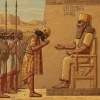
Harold W. Hoehner
The Day of Christ's Birth
"The
traditional date for the birth of Christ from as early as
Hippolytus (ca. A.D. 165-235) has been December 25th. In the
Eastern Church January 6th was the date for not only
Christ's birth, but also the arrival of the Magi on Christ's
second birthday, His baptism in His twenty-ninth year, and
the sign at Cana in His thirtieth year. However Chrysostom
(A.D. 345-407) in 386 stated that December 25th is the
correct date and hence it became the official date for
Christ's birth in the Eastern Church (January 6th was still
considered the day for the manifestations of the coming of
the Magi, the baptism, and the sign at Cana.
Although the exact date may not be pinpointed it seems that
there is a relatively old tradition of a midwinter birth,
therefore a date in December or January is not in itself
unlikely.
The one objection raised for the winter date is the fact of
the shepherds attending their flock in the night (Luke 2:8).
Usually, it is noted, the sheep were taken into enclosures
from November until March and were not in the fields at
night. However, this is not conclusive evidence against
December being the time of Christ's birth for the following
reasons. First, it could have been a mild winter and hence
the shepherds would have been outside with their sheep.
Second, it is not at all certain that sheep were brought
under cover during the winter months. Third, it is true that
during the winter months the sheep were brought in the from
the wilderness. The Lukan narrative states that the
shepherds were around Bethlehem (rather than the
wilderness), thus indicating that the nativity was in the
winter months. Finally, the Mishnah (Shekalim 7:4) implies
that the sheep around Bethlehem were outside all year, and
those that were worthy for the Passover offerings were in
the fields thirty days before the feast, which would be as
early as February, one of the coldest and rainiest months of
the year. Therefore, a December date for the nativity is
acceptable.
In conclusion, the exact date of the birth of Christ is
difficult to know with finality. However, a midwinter date
is most likely. It is clear that Christ was born before
Herod the Great's death and after the census. In looking at
the birth narratives of Matthew and Luke one would need to
conclude that Christ was born of Mary within a year or two
of Herod's death. In looking to some of the other
chronological notations in the Gospels, the evidence led to
the conclusion that Christ was born in the winter of 5/4
B.C. Although the exact date of Christ's birth cannot be
known, either December of 5 B.C., or January of 4 B.C. is
most reasonable."
Read The Bible
- 1599 Geneva Bible (GNV)
- 21st Century King James Version (KJ21)
- American Standard Version (ASV)
- Amplified Bible (AMP)
- Amplified Bible, Classic Edition (AMPC)
- Authorized (King James) Version (AKJV)
- BRG Bible (BRG)
- Christian Standard Bible (CSB)
- Common English Bible (CEB)
- Complete Jewish Bible (CJB)
- Contemporary English Version (CEV)
- Darby Translation (DARBY)
- Disciples’ Literal New Testament (DLNT)
- Douay-Rheims 1899 American Edition (DRA)
- Easy-to-Read Version (ERV)
- English Standard Version (ESV)
- English Standard Version Anglicised (ESVUK)
- Evangelical Heritage Version (EHV)
- Expanded Bible (EXB)
- GOD’S WORD Translation (GW)
- Good News Translation (GNT)
- Holman Christian Standard Bible (HCSB)
- International Children’s Bible (ICB)
- International Standard Version (ISV)
- J.B. Phillips New Testament (PHILLIPS)
- Jubilee Bible 2000 (JUB)
- King James Version (KJV)
- Lexham English Bible (LEB)
- Living Bible (TLB)
- Modern English Version (MEV)
- Mounce Reverse Interlinear New Testament (MOUNCE)
- Names of God Bible (NOG)
- New American Bible (Revised Edition) (NABRE)
- New American Standard Bible (NASB)
- New American Standard Bible 1995 (NASB1995)
- New Catholic Bible (NCB)
- New Century Version (NCV)
- New English Translation (NET)
- New International Reader's Version (NIRV)
- New International Version - UK (NIVUK)
- New International Version (NIV)
- New King James Version (NKJV)
- New Life Version (NLV)
- New Living Translation (NLT)
- New Matthew Bible (NMB)
- New Revised Standard Version (NRSV)
- New Revised Standard Version Catholic Edition (NRSVCE)
- New Revised Standard Version, Anglicised (NRSVA)
- New Revised Standard Version, Anglicised Catholic Edition (NRSVACE)
- New Testament for Everyone (NTE)
- Orthodox Jewish Bible (OJB)
- Revised Geneva Translation (RGT)
- Revised Standard Version (RSV)
- Revised Standard Version Catholic Edition (RSVCE)
- The Message (MSG)
- The Voice (VOICE)
- Tree of Life Version (TLV)
- World English Bible (WEB)
- Worldwide English (New Testament) (WE)
- Wycliffe Bible (WYC)
- Young's Literal Translation (YLT)
Table of Contents
Main Menu
- Ancient Assyrian Social Structure
- Ancient Babylonia
- Ancient Canaan During the Time of Joshua
- Ancient History Timeline
- Ancient Oil Lamps
- Antonia Fortress
- Archaeology of Ancient Assyria
- Assyria and Bible Prophecy
- Augustus Caesar
- Background Bible Study
- Bible
- Biblical Geography
- Fallen Empires - Archaeological Discoveries and the Bible
- First Century Jerusalem
- Glossary of Latin Words
- Herod Agrippa I
- Herod Antipas
- Herod the Great
- Herod's Temple
- High Priest's in New Testament Times
- Jewish Literature in New Testament Times
- Library collection
- Map of David's Kingdom
- Map of the Divided Kingdom - Israel and Judah
- Map of the Ministry of Jesus
- Matthew Henry Bible Commentary
- Messianic Prophecy
- Nero Caesar Emperor
- Online Bible Maps
- Paul's First Missionary Journey
- Paul's Second Missionary Journey
- Paul's Third Missionary Journey
- Pontius Pilate
- Questions About the Ancient World
- Tabernacle of Ancient Israel
- Tax Collectors in New Testament Times
- The Babylonian Captivity
- The Black Obelisk of Shalmaneser
- The Books of the New Testament
- The Court of the Gentiles
- The Court of the Women in the Temple
- The Destruction of Israel
- The Fall of Judah with Map
- The History Of Rome
- The Incredible Bible
- The Jewish Calendar in Ancient Hebrew History
- The Life of Jesus in Chronological Order
- The Life of Jesus in Harmony
- The Names of God
- The New Testament
- The Old Testament
- The Passion of the Christ
- The Pharisees
- The Sacred Year of Israel in New Testament Times
- The Samaritans
- The Scribes
Ancient Questions
- Why Do the Huldah Gates Appear Different in Ancient Replicas and Modern Photos?
- What Is the Origin of the Japanese and Chinese Peoples? A Biblical Perspective
- How did the ancient Greeks and Romans practice medicine and treat illnesses?
- What were the major contributions of ancient Babylon to mathematics and astronomy?
- How did the ancient Persians create and administer their vast empire?
- What were the cultural and artistic achievements of ancient India, particularly during the Gupta Empire?
- How did ancient civilizations like the Incas and Aztecs build their remarkable cities and structures?
- What were the major trade routes and trading practices of the ancient world?
- What was the role of slavery in ancient societies like Rome and Greece?
- How did the ancient Mayans develop their sophisticated calendar system?
Bible Study Questions
- Why Do Christians Celebrate Christmas?
- How Many Chapters Are There in the Bible?
- The Five Key Visions in the New Testament
- The 400-Year Prophecy: Unpacking Genesis 15 and the Journey of a People
- The Authorized (King James) Version (AKJV): Historical Significance, Translation Methodology, and Lasting Impact
- Exploring the English Standard Version (ESV): Its Aspects, Comparisons, Impact on Biblical Studies, and Church Use
- A Detailed Historical Analysis of Language Updates in the KJ21: Comparison with Other Versions
- A Detailed Historical Analysis of the American Standard Version (ASV): Comparison to the King James Version, Influence on Later Translations, and Evaluation of Strengths and Weaknesses
- A Detailed Historical Analysis of Amplifications in the Amplified Bible (AMP) and Its Comparison to Other Bible Translations
- Detailed Historical Analysis of the Amplified Bible Classic Edition (AMPC): Examples of Amplifications and Comparative Analysis with Other Bible Translations
About
Welcome to Free Bible: Unearthing the Past, Illuminating the Present! Step into a world where ancient history and biblical narratives intertwine, inviting you to explore the rich tapestry of human civilization.
Discover the captivating stories of forgotten empires, delve into the customs and cultures of our ancestors, and witness the remarkable findings unearthed by dedicated archaeologists.
Immerse yourself in a treasure trove of knowledge, where the past comes alive and illuminates our understanding of the present.
Join us on this extraordinary journey through time, where curiosity is rewarded and ancient mysteries await your exploration.
Recent posts
-

How to Wear a Cross Pendant as a Daily Reminder of Your Faith
Picture this: each morning, you grab a little piece of metal—cool to the touch—and slide it around your neck. It’s a cross pendant, nothing fanc... -

The Grimanis: A Family Dedicated to Public Health and Philanthropy
In the serene outskirts of London, the Grimani family stands as a beacon of dedication to public health and social responsibility. Led by Dr. John Leo... -

Jehu Bows Before Shalmaneser III: A Unique Depiction in Ancient Near Eastern Art
One of the most fascinating and historically significant reliefs from the ancient Near East is the depiction of Jehu, king of Israel, bowing before th... -

A Joyful Tradition: The History of the Jubilee in the Catholic Church
Every so often, the Catholic Church invites the faithful to celebrate a special time of grace and renewal known as a Jubilee. This long-standing tradi... -

Healthlion Medical Solutions and LionHeart Family Institute Publish Comprehensive Study on Physician-Owned Family Practices in the U.S.
Healthlion Medical Solutions and the LionHeart Family Institute have officially concluded their extensive 12-month research on the future of physician...